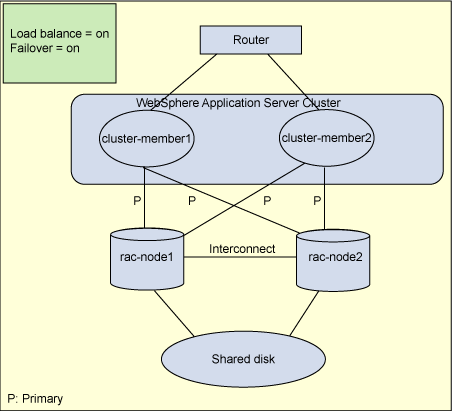Network Deployment (Distributed operating systems), v8.0 > Establishing high availability > Establishing high availability for Data access resources > Configure Oracle Real Application Cluster (RAC) with the application server
Configure a simple RAC configuration in an application server cluster
Oracle Real Application Cluster (RAC) is a "share-everything" database architecture that can provide high availability and load balancing. A typical configuration for an Oracle RAC contains two or more Oracle RAC nodes that are clustered together and share the same storage. This figure depicts a typical RAC physical topology in a cluster environment for the application server, and both the failover and load balancing are enabled:

In the figure
above, the application server cluster consists of two members: cluster-member1
and cluster-member2. The Oracle RAC physical configuration contains two nodes: rac-node1 and rac-node2. The RAC nodes can be located in the same physical machine with the cluster members, or they could
be placed in entirely different machines. The actual placement does not impact the fundamental qualities of the services provided by RAC.
To achieve both high availability and load-balancing, you can specify the Oracle data source URL for both cluster members in the application server with the required properties.
Procedure
- Navigate to the Oracle data source. Click Resources > JDBC > Data sources > oracle_data_source . If you don't already have an Oracle data source, create a new data source by clicking New and completing the wizard. For the URL, substitute the properties in the next step.
- Set the URL for the Oracle database with the required configuration parameters.
jdbc:oracle:thin:@(DESCRIPTION=(ADDRESS_LIST= (ADDRESS=(PROTOCOL=TCP)(HOST=rac-node1)(port=1521)) (ADDRESS=(PROTOCOL=TCP)(HOST=rac-node2)(port=1521))) (FAILOVER=on)(LOAD_BALANCE=on) (CONNECT_DATA=(SERVER=DEDICATED) (SERVICE_NAME= <service_name>)))Be aware of these configuration options:
- If you are not using Oracle services, then service_name will be the database name in the example. If you are using Oracle services, then service_name will be the name of the services.
- The example has FAILOVER and LOAD_BALANCE turned on.
To turn one or both of these features off, change on to off in the above example.
- Click Apply or OK.
Configure Oracle connection caching in the application server
Configure two-phase commit distributed transactions with Oracle RAC
Configure Oracle Real Application Cluster (RAC) with the application server
Configure a JDBC provider and data source